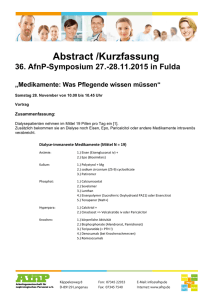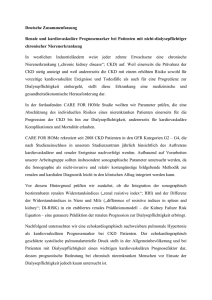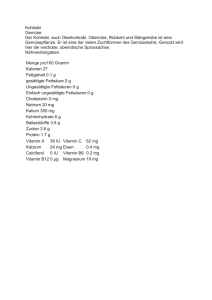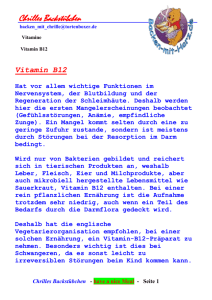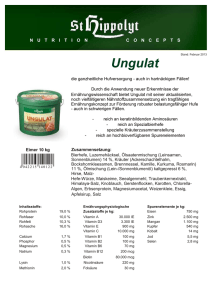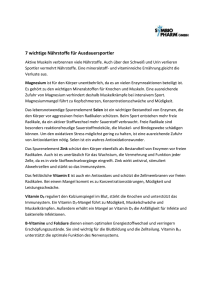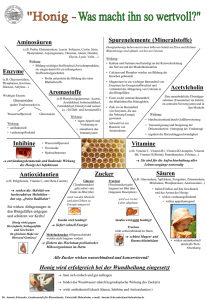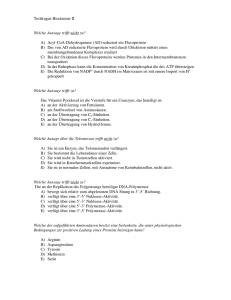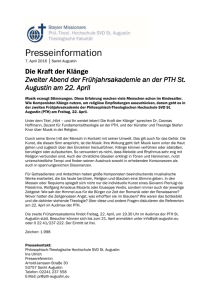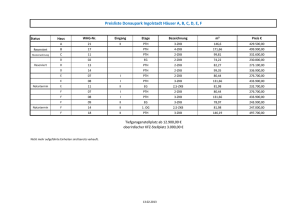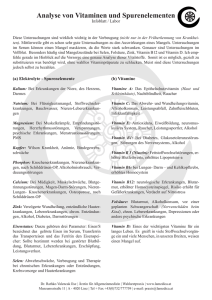Vitamin D
Werbung
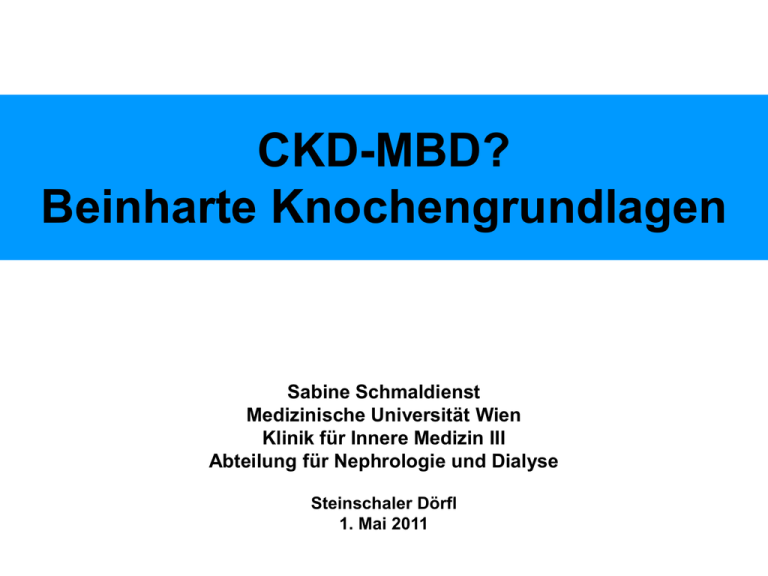
CKD-MBD? Beinharte Knochengrundlagen Sabine Schmaldienst Medizinische Universität Wien Klinik für Innere Medizin III Abteilung für Nephrologie und Dialyse Steinschaler Dörfl 1. Mai 2011 Die Hauptdarsteller • Parathormon (PTH) • Kalzium • Phosphat • Vitamin D Terminologie Disturbances in mineral and bone metabolism are prevalent in CKD and are an important cause of morbidity, decreased quality of life, and extraskeletal calcification that have been associated with increased cardiovascular mortality. Renal osteodystrophy The term renal osteodystrophy should be used exclusively to define alterations in bone morphology associated with CKD The term CKD-MBD should be used to describe a broader clinical syndrome that develops as a systemic disorder of mineral and bone metabolism due to CKD, which is manifasted by abnormalities in bone and mineral metabolism and/or extraskeletal calcification. Moe S et al. Kidney Int 2006;69:1945 Renale Osteodystrophie Klassifikation Typische Knochenveränderungen Osteitis fibrosa cystica „high turnover“ – Ausdruck des sekundären und tertiären Hyperparathyreoidismus gekennzeichnet durch einen stark erhöhten Knochenumsatz Osteomalazie „low turnover“ – verminderter und verlangsamter Knochenumsatz; Volumen des nicht mineralisierten Knochens nimmt zu häufig bei Aluminiumüberladung Adynamische Knochenerkrankung „low turnover“ – häufigste Störung Knochenumsatz und Osteoidbildung vermindert oft bei Unterdrückung der NSD-Aktivität (Vit-D Präparate, Ca-hältige Phosphatbinder, Dialysat-Kalzium Amyloidose des Knochens b2-M assoziiert bei Langzeitdialyse, Knochenzysten Gemischte Osteodystrophie Osteitis fibrosa cystica Osteitis fibrosa cystica „high turnover“ – Ausdruck des sekundären und tertiären Hyperparathyreoidismus gekennzeichnet durch einen stark erhöhten Knochenumsatz Osteitis fibrosa cystica Ursachen: Phosphat-Retention erniedrigtes freies Kalzium erniedrigtes 1,25-Vitamin D Osteomalazie Osteomalazie „low turnover“ – verminderter und verlangsamter Knochenumsatz; Volumen des nicht mineralisierten Knochens nimmt zu 1,25 Vitamin D-Mangel häufig bei Aluminiumüberladung Aluminium und Knochen Miler PD. cJASN 2008;3:140 Adynamische Knochenerkrankung Adynamische Knochenerkrankung „low turnover“ – häufigste Störung Knochenumsatz und Osteoidbildung vermindert oft bei Unterdrückung der NSD-Aktivität (Vit-D Präparate, Cahältige Phosphatbinder, Dialysat-Kalzium, Cinacalcet) Gesunder Knochen Adynamer Knochen Osteoklasten fehlen = reduzierter Abbau von „altem Knochen“ Faktoren die eine ABD begünstigen Hohe Kalziumbelastung Niedere PTH-Werte Vitamin D Überdosierung Höheres Lebensalter Diabetes mellitus CAPD verglichen mit HD Amyloidose Amyloidose des Knochens b2-M assoziiert bei Langzeitdialyse, Knochenzysten Röntgenbilder der renalen Osteodystrophie Images from Kline MJ. 2001. Available at: http://www.emedicine.com/radio/topic500.htm Reprinted with permission from eMedicine.com, Inc., 2003. ROD Veränderungen über die Zeit Malluche HH et al. Nephrol Dial Transplant 2004;19:S9 Hüftfraktur-Risiko (Männer) 3.65 4 Hazard Ratio (CI 95% 1.87-7.13) 3 x häufiger 3 2 1.23 1.00 (CI 95% 0.84-1.79) 1 0 GFR (mL/min/1.73 m2): CKD 0–2 CKD 3 CKD 4 ≥ 60 30–59 15–29 N = 13,632 CKD 3–4 N = 19,459 CKD 0–2 Dooley AC et al. Am J Kidney Dis 2008;51:38-44 Evidenz von Beobachtungsstudien: Steigende PTH Werte können das Risiko von Frakturen steigern Fracture risk Relative risk of fracture per 100 pg/mL increase in PTH Hip Vertebral + 33% 1.50 1.25 per 100 pg/mL increase + 15% per 100 pg/mL increase 1.00 Baseline PTH 300–800 pg/mL Danese MD et al. Am J Kidney Dis 2006;47:149–156 Einfluss von PTH auf die Entwicklung und das Fortschreiten der renalen Osteodystrophie Low turnover Low Adynamic Osteomalacia High turnover PTH Normal Bone Formation High Osteitis Fibrosa Mixed Lesion < 150 pg/ml 150 – 300 pg/ml > 300 pg/ml Entwicklung der NSD-Hyperplasie Synthesis PTH Levels/Disease Severity Secretion Progression of Hyperplasia Polyclonal: VDR Monoclonal: VDR CaR CaR Normal ↑ Secretory Cells Minutes Hours/Days Adaptive Diffuse Hyperplasia Early Nodularity Nodular Weeks/Years Pathologic Single Nodule Mehr als nur der Knochen Vaskuläre Verkalkungen Gefäßverkalkungen Prävalenz von vaskulären Kalzifikationen (CT) bei Gesunden und Patienten mit CKD 4 + 5 Gefäßverkalkungen und Überleben HD-Patienten Extraartikuläre Verkalkungen Calcitriol 1,25(OH)2D3 (pg/mL) 50 40 ● 1,25D ● ● CKD Stage 2 Stage 3 Stage 4 ● 30 20 Lower range of 1,25D ● ● ● ● ● ● ● 10 0 105 95 85 75 65 55 45 35 GFR (mL/min/1.73 m2) 25 15 100 90 80 70 60 50 40 30 20 10 Patients With Elevated PTH (%)* Niereninsuffizienz – KHK Rolle des 1,25 (OH)2 Vitamin D iPTH und kardiovaskuläre Mortalität Marco MP et al. Kidney Int 2003;63:111 Zusammenhang zwischen PTH und Überleben Kalantar-Zadeh K et al. Kidney Int 2010;78:S10 Vitamin D-zentrisches Weltbild Wetmore, Nature Clin Pract Nephrol 2009 1,25 (OH)2 Vitamin D-Spiegel bei HDPatienten (n=825) Mangel nieder Wolf M et al. Kidney Int 2007;72:1004 Vitamin D – Einfluss auf S-Kalzium Slatopolsky. J Clin Invest 1984 1.8 iPTH Referent group 1.6 1.4 * 1.2 1.0 0.8 0.6 0.0 < 150 150–300 300–600 > 600 Relative Risk of Death (n = 40,538) Relative Risk of Death (n = 34,543) PTH, Calcium und Phosphat sind mit erhöhter Morbidität und Mortalität vergesellschaftet 2.5 2.0 1.5 0.0 Ca x P (mg2/dL2) 1.4 1.2 1.0 0.8 0.6 0.0 Corrected Serum Calcium (mg/dL) Phosphat Relative Risk of Death (n = 40,538) Relative Risk of Death (n = 40,538) 1.6 * * 0.5 Calcium Referent group * * * * * 1.0 Plasma iPTH (pg/mL) 1.8 Ca x P Referent group 2.2 2.0 1.8 1.6 1.4 1.2 1.0 0.6 0.0 * Referent group * * * * Serum phosphorous (mg/dL) Block, J Am Soc Nephrol 2004 All-Cause and Cardiac Mortality vs. Serum-Phosphorus Sammeldaten aus 4 RCT 1184 Patienten unkontrollierbarer sHPT Hyperphosphatämie manifestiert erst im CKD Stadium 4 + 5 Kestenbaum B et al. J Am Soc Nephrol. 2004;16:520-528 Neues Weltbild Phosphor – FGF23 Erhöhtes Serumphosphat Wetmore, Nature Clin Pract Nephrol 2009 FGF23 and chronic kidney disease (CKD) stage inversely correlate with each other Guiterrez et al. J Am Soc Nephrol 2005; 16:2205-15 FGF-23 vs. Phosphat Quartilen & Mortalität FGF-23 Phosphat Odds ratio of mortality 6 5 4 3 2 1 0 Q1 Q2 Q3 Q4 Serum phosphate quartiles (mg/dl) Gutierrez, N Engl J Med 2008 Relative Hazard of Death (95% CI) Mortalitätsrisiko Erreichen von Zielwerten 1,8 Three Targets 1,6 (Reference) Two Targets One Target No Targets 1,51 1,39 1,4 1,21 1,2 1,37 1,35 1,20 1,15 1,00 1,0 0,8 All N = 22,937 iPTH &P iPTH Ca & P iPTH & Ca P Groups Defined by Targets Achieved Ca None Danese MD et al. Clin J Am Soc Nephrol 2008;3:1423-1429 Relative Hazard of Death (95% CI) Mortalitätsrisiko Erreichen von Zielwerten - Zeit 2.0 iPTH Calcium Phosphorous 1.8 1.62 1.6 1.48 Reference 1.34 1.4 1.20 1.2 1.16 1.12 1.15 1.00 1.0 0.8 1.41 Reference 1 N = 17,828 2 3 4 Reference 1.001.00 1 2 3 4 1.00 1 2 3 4 Number of Quarters in Target in First Year Danese MD et al. Clin J Am Soc Nephrol 2008;3:1423-1429 Wo fangen wir an? Schlachtfeld CKD-MBD Kalzium, Vitamin D und Phosphatbinder Konfusion Kovesdy CP et al. Clin J Am Soc Nephrol 2008;3:168 1,25 (OH)2 Vitamin D und Kalzifizierung Shroff R et al. JASN 2008;19:1239 1,25 (OH)2 Vitamin D-Spiegel bei HDPatienten Wolf M et al. Kidney Int 2007;72:1004 Orales Calcitriol reduziert Mortalität bei Dialysepatienten CORES-Study, n~16.000 Naves-Diaz M et al. Kidney Int 2008;74:1070 Vitamin D: Die Dosis macht das Gift! Phosphate binders have similar efficacy in reducing serum phosphate levels Serum phosphorus levels (mg/dL) 8.6 7.8 7.0 6.3 5.5 4.7 4.5 0 4 8 12 16 20 24 28 32 36 40 44 48 Time (weeks) Ca (TTG)1 Sevelamer (TTG)1 Lanthanum2 Adapted from: 1. Chertow GM et al. Kidney Int 2002;62:245–252 2. Hutchison A. 2003 World Congress of Nephrology; Berlin, Germany 3. Qunibi W et al. Kidney Int 2004;65:1914–1926 Ca (CARE)3 52 Does CaxP play a role in vascular calcification? Clinical Evidence RIND-Study Block GA et al. Kidney Int 2005;68:1815 Ca-Konzentration im Dialysat Cinacalcet improves all metabolic endpoints in OPTIMA BCT Cinacalcet Mean (SE) change from baseline (%) iPTH Ca** P 20 10 Ca x P 5% 4% 2% n=184 n=368 1% 0 -10 -7% -20 -5% -12% -30 -40 -50 -46% -60 Messa, Clin J Am Soc Nephrol 2008 Cinacalcet reduziert kardiovaskuläre Krankenhausaufenthalte Cunningham J et al. Kidney Int 2005;68:1793 ADVANCE Study: Cinacalcet + Vit D vs. Vit D alone Primärer Endpunkt Raggi P et al. Nephrol Dial Transplant 2010, epub ahead ADVANCE Study: Cinacalcet + Vit D vs. Vit D alone Raggi P et al. Nephrol Dial Transplant 2010, epub ahead Für alles musste einmal die richtige Verwendung gefunden werden CKD-MBD Konsequenzen Laboratory Abnormalities Calcification Renal Osteodystrophy Abnormal calcium, phosphorous, PTH, vitamin D metabolism Vascular or other soft Calcification tissue calcification Abnormal bone turnover, mineralization, volume, linear growth, or strength Clinical Consequences • • • • Bone pain • Cardiovascular events Fractures • Hospitalization Parathyroid hyperplasia • Mortality Parathyroidectomy
